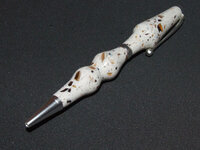expotecs
Member
Hello fellow pen turners,
This is my first corian pen, I had a box of scrap corian from my construction days, and decided to turn a pen with some of it today.
I glued two pieces together using Med CA glue, let it sit for a half hour then cut the blanks to length and drilled, slowly drilled the holes.
It turned nicely, didn't have any blowouts or large voids to deal with and I finished it up with the MM series to 12000. My only complaint is that you can see the joint line, where the two pieces are glued together.
So, my question to all of you, who have experience with corian, is it possible to diminish that line ? I don't expect it to be gone completely, but I would like to make it thiner and less noticeable.
Comments / Suggestions
Thanks
Steve --
PS, thanks to all the responded to my first posting of pens.
This is my first corian pen, I had a box of scrap corian from my construction days, and decided to turn a pen with some of it today.
I glued two pieces together using Med CA glue, let it sit for a half hour then cut the blanks to length and drilled, slowly drilled the holes.
It turned nicely, didn't have any blowouts or large voids to deal with and I finished it up with the MM series to 12000. My only complaint is that you can see the joint line, where the two pieces are glued together.
So, my question to all of you, who have experience with corian, is it possible to diminish that line ? I don't expect it to be gone completely, but I would like to make it thiner and less noticeable.
Comments / Suggestions
Thanks
Steve --
PS, thanks to all the responded to my first posting of pens.

